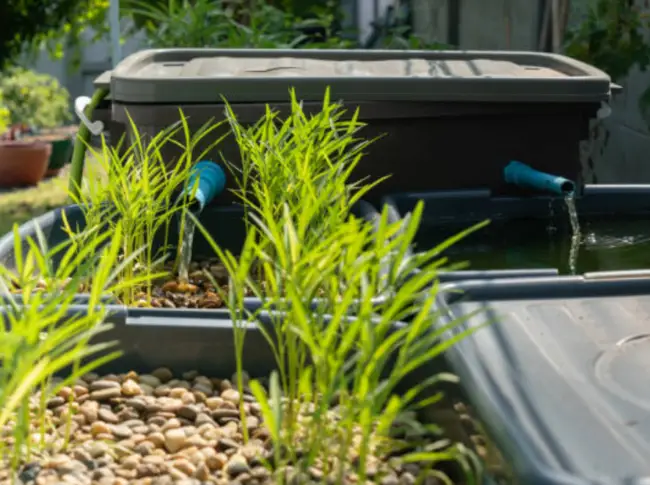Bacteria are the unsung heroes of aquaponics systems. They play a crucial role in maintaining the delicate balance that makes these systems thrive. But what exactly is their role? In short, bacteria are responsible for converting fish waste into nutrients that plants can absorb.
This process, known as nitrification, is the backbone of aquaponics. Without these bacteria, the system would quickly become unbalanced, leading to poor plant growth and potentially harming the fish. So, what role do bacteria play in an aquaponics system? Let’s dive deeper and uncover their fascinating contribution.
What Role Do Bacteria Play in an Aquaponics System?
Aquaponics is a sustainable and innovative farming method that combines aquaculture (fish farming) with hydroponics (soilless plant cultivation). In this unique system, plants and fish coexist in a mutually beneficial relationship.
While fish provide waste as a nutrient source for plants, plants filter the water, creating a healthy environment for the fish. At the heart of this symbiotic relationship are bacteria, which play a crucial role in maintaining the balance and functionality of the aquaponics system.
The Nitrogen Cycle in Aquaponics
To understand the role of bacteria in an aquaponics system, we need to explore the nitrogen cycle. Nitrogen is an essential nutrient for plant growth, but in its organic form, it is not readily available to plants.
This is where bacteria step in. The nitrogen cycle consists of several stages facilitated by different types of bacteria:
1. Ammonia Production: Fish excrete ammonia through their gills and waste. This ammonia is toxic to both fish and plants. However, certain bacteria called nitrosomonas convert ammonia into nitrite, a less harmful form of nitrogen.
2. Nitrite Oxidation: Another group of bacteria known as nitrobacter convert nitrite into nitrate, a form of nitrogen that plants can readily absorb and utilize for growth.
3. Nitrate Assimilation: Finally, plants take up nitrate from the water through their roots, utilizing it to synthesize amino acids, proteins, and other essential compounds for development.
4. Plant Uptake: As plants consume the nitrates, the water is naturally purified, removing excess nutrients that can be harmful to fish.
5. Back to Ammonia: Eventually, bacteria called nitrosomonas europaea convert the excess nitrate back into ammonia, closing the nitrogen cycle.
Read More: About Does Sand Prevent Weed Growth: Know The Truth!
The Role of Bacteria in Breaking Down Waste
Apart from their involvement in the nitrogen cycling process, bacteria also play a vital role in breaking down fish waste and organic matter in an aquaponics system. These bacteria, known as decomposers, break down complex organic compounds into simpler substances that can be easily absorbed by plants. This process helps maintain a healthy and balanced ecosystem within the aquaponics system.
Benefits of Bacteria in an Aquaponics System
The presence of bacteria in an aquaponics system offers several key benefits:
– Nutrient Cycling: Bacteria facilitate the conversion of fish waste into plant-available nutrients, ensuring a continuous supply of essential elements for robust plant growth.
– Water Purification: As bacteria convert toxic ammonia into nitrate, they effectively remove harmful substances from the water, creating a safe and clean environment for the fish.
– Preventing Nitrogen Build-up: By converting excess nitrate back into ammonia, bacteria prevent the accumulation of nitrogen compounds, reducing the risk of toxicity for fish.
– Enhanced Plant Growth: The presence of beneficial bacteria in the root zone improves nutrient uptake and enhances plant growth, leading to healthier and more abundant yields.
– Biological Filter: Bacteria serve as a biological filter, breaking down organic matter and maintaining water quality by removing pollutants and excess nutrients.
Establishing Bacteria in an Aquaponics System
To ensure the successful establishment and maintenance of beneficial bacteria in an aquaponics system, certain considerations should be taken into account:
– Seed Bacteria: Introducing a bacterial culture or media that contains beneficial bacteria into the system can accelerate the establishment of the nitrogen cycle. This can be done by adding a commercial bacterial product specifically formulated for aquaponics or using established biofilters from existing systems.
– Water Quality: Maintaining optimal water quality parameters such as pH, temperature, and oxygen levels is crucial for bacterial activity. Regular water testing and appropriate adjustments should be conducted to create an ideal environment for bacteria to thrive.
– Stocking Density: The number of fish stocked in the aquaponics system should be managed to prevent overloading the bacteria’s capacity to convert waste into plant nutrients. Proper fish-to-plant ratio ensures a sustainable balance between waste production and nutrient utilization.
– Temperature and Bacteria Activity: Bacteria are temperature-dependent, and their activity increases with higher temperatures. Monitoring and maintaining suitable water temperatures promote optimum bacterial function and nutrient cycling efficiency.
The Importance of Bacteria Monitoring in Aquaponics
Continuous monitoring of bacterial activity is crucial in an aquaponics system to ensure its proper functioning. Regular water testing for ammonia, nitrite, and nitrate levels provides insights into the bacteria’s efficiency at converting waste and maintaining the nitrogen cycle.
In addition, monitoring pH levels and dissolved oxygen content helps create and sustain the ideal conditions for bacterial growth. Any deviations from the optimal ranges should be promptly addressed to avoid detrimental effects on the system.
Bacteria play a fundamental role in the success of an aquaponics system. They drive the nitrogen cycle, converting fish waste into plant nutrients and creating a symbiotic relationship between fish and plants. By establishing and maintaining beneficial bacteria, aquaponic farmers can achieve sustainable and efficient food production.
Understanding the role of bacteria and implementing appropriate monitoring and management strategies ensure the long-term health and productivity of this innovative farming method.
Read More: The Marigold-Tomato Connection: A Gardening Love Story
Frequently Asked Questions (FAQs)
Bacteria play a crucial role in an aquaponics system. They are responsible for converting toxic fish waste (ammonia) into usable nutrients for the plants.
This process, called nitrification, involves two types of bacteria: Nitrosomonas, which convert ammonia into nitrites, and Nitrobacter, which further convert nitrites into nitrates. These nitrates are then absorbed by the plants as their primary source of nutrients.
Bacteria are introduced into an aquaponics system through various sources. They naturally colonize on surfaces such as the grow bed media, fish tank walls, and plumbing. Bacteria can also be seeded into the system by adding a bacterial supplement or using a biofilter.
Over time, a healthy population of beneficial bacteria will establish and thrive, ensuring the system’s proper functioning.
An imbalance of bacteria in an aquaponics system can have negative consequences. If there is an insufficient amount of beneficial bacteria, ammonia levels can increase, posing a threat to the fish.
Conversely, an excess of bacteria can lead to high nitrate levels, negatively impacting plant growth and potentially harming fish. Maintaining a balanced bacterial population is crucial for the overall health of the aquaponics system.
To promote the growth of beneficial bacteria, it is essential to provide them with favorable conditions. This includes maintaining appropriate water temperature, pH levels, and oxygen levels. Additionally, avoiding the use of chemicals or harmful substances that can disrupt the bacterial colony is crucial.
Regularly monitoring water parameters and conducting regular system maintenance will contribute to a healthy environment for bacteria to thrive.
Yes, adding bacteria supplements to your aquaponics system can be beneficial, especially during the initial setup phase or when the system undergoes significant changes. Bacteria supplements can help establish and accelerate the colonization of beneficial bacteria, ensuring a quicker and smoother cycling process.
However, it is important to choose a reputable product and follow the manufacturer’s instructions for proper application.
A healthy bacterial colony can be observed through several indicators. One sign is the absence of ammonia and nitrite spikes, indicating that the bacteria are effectively converting these compounds into nitrates.
Additionally, clear and odorless water, thriving plants, and healthy fish are also signs of a well-established and balanced bacterial population in the aquaponics system.
Introducing beneficial bacteria from an established aquaponics system can be a viable option to jumpstart the colonization process.
However, it is crucial to ensure that the bacteria being introduced are compatible with the new system’s specific conditions. Transferring bacteria from a healthy and well-maintained system can help establish a robust bacterial population in the new aquaponics system more rapidly.
Regular testing of bacteria levels in an aquaponics system is essential to monitor and maintain a healthy balance. Testing for ammonia, nitrites, and nitrates should be performed at least once a week, especially during the system’s early stages.
As the system matures and stabilizes, testing frequency can be reduced to once every two weeks or as needed based on any observed changes or issues with the system.
Final Thoughts
Bacteria play a vital role in an aquaponics system. These microorganisms are responsible for converting toxic ammonia, produced by fish waste, into nitrites and nitrates. This process, known as nitrification, provides essential nutrients to the plants. Additionally, bacteria help break down organic matter, maintaining the system’s balance and preventing the accumulation of harmful substances.
Without bacteria, the aquaponics system would not be able to function effectively, as they are crucial for maintaining water quality and promoting plant growth. In conclusion, bacteria are fundamental in an aquaponics system, facilitating nutrient cycling and ensuring a mutually beneficial relationship between the fish and plants.
Auto Amazon Links: No products found.
Perfect Plants Christmas Tree Saver 8oz. | Easy Use Xmas Tree Preserver Food | Have Healthy Green Christmas Trees All Holiday Season
$9.97 (as of December 11, 2025 04:08 GMT +00:00 - More info- Product prices and availability are accurate as of the date/time indicated and are subject to change. Any price and availability information displayed on [relevant Amazon Site(s), as applicable] at the time of purchase will apply to the purchase of this product.
Rocky Mountain Goods Christmas Tree Food - 8 oz Tree Preservative - Reduce Needle Drop - Greener Scent - Fir, Pine, Spruce Trees - Extend Tree Life
$9.95 (as of December 11, 2025 04:08 GMT +00:00 - More info- Product prices and availability are accurate as of the date/time indicated and are subject to change. Any price and availability information displayed on [relevant Amazon Site(s), as applicable] at the time of purchase will apply to the purchase of this product.
VICAMB 39.3 Inch Christmas Tree Watering Funnel,Christmas Tree Watering System Device,Long Tree Watering Funnel Spout for Indoor Outdoor Xmas Tree
$16.99 (as of December 11, 2025 04:08 GMT +00:00 - More info- Product prices and availability are accurate as of the date/time indicated and are subject to change. Any price and availability information displayed on [relevant Amazon Site(s), as applicable] at the time of purchase will apply to the purchase of this product.
SUNEZLGO Christmas Tree Watering Funnel, Christmas Tree Watering System Tree Waterer, Real Christmas Tree Water Funnel, Xmas Adjustable Metal Tubes Spout for Indoor Outdoor Christmas Tree
$19.99 (as of December 11, 2025 04:08 GMT +00:00 - More info- Product prices and availability are accurate as of the date/time indicated and are subject to change. Any price and availability information displayed on [relevant Amazon Site(s), as applicable] at the time of purchase will apply to the purchase of this product.
EZMeetU Christmas Tree Watering Funnel, 47 Inch Flower Shape Adjustable 6 Section Design, Christmas Tree Watering System, Christmas Tree Waterer, Long Funnel Wide Opening Reusable, Plant Watering Tool
$16.99 (as of December 11, 2025 04:08 GMT +00:00 - More info- Product prices and availability are accurate as of the date/time indicated and are subject to change. Any price and availability information displayed on [relevant Amazon Site(s), as applicable] at the time of purchase will apply to the purchase of this product.
Muddy Mat® Shown on TV Super Absorbent Microfiber Dog Door Mat for Muddy Paws, Non-Slip Washable Pet Rug, Quick Dry Chenille Entryway Carpet, Machine Washable Indoor Outdoor mat, Grey 30"x19"
$24.95 (as of December 9, 2025 17:49 GMT +00:00 - More info- Product prices and availability are accurate as of the date/time indicated and are subject to change. Any price and availability information displayed on [relevant Amazon Site(s), as applicable] at the time of purchase will apply to the purchase of this product.
Snow Joe Premium Enviro Blend Ice Melt, Green-Coated Deicer Crystals, 50 lb - Safer Melter for Vegetation, Concrete & Metals w/ Anti-Corrosion Calcium Magnesium Acetate
$32.97 (as of December 9, 2025 17:49 GMT +00:00 - More info- Product prices and availability are accurate as of the date/time indicated and are subject to change. Any price and availability information displayed on [relevant Amazon Site(s), as applicable] at the time of purchase will apply to the purchase of this product.
Zevo Flying Insect Trap Official Refill Cartridges - Fits Both Zevo Trap & MAX Indoor Fly Trap - Authentic Trap+Lock Technology to Catch Gnats, House & Fruit Flys (4 Official Refill Cartridges)
$11.01 (as of December 9, 2025 17:49 GMT +00:00 - More info- Product prices and availability are accurate as of the date/time indicated and are subject to change. Any price and availability information displayed on [relevant Amazon Site(s), as applicable] at the time of purchase will apply to the purchase of this product.
OLANLY Dog Door Mat for Muddy Paws 30x20, Absorbs Moisture and Dirt, Absorbent Non-Slip Washable Doormat, Quick Dry Chenille Mud Mat for Dogs, Entry Indoor Entryway Carpet for Inside Floor, Grey
$9.99 (as of December 9, 2025 17:49 GMT +00:00 - More info- Product prices and availability are accurate as of the date/time indicated and are subject to change. Any price and availability information displayed on [relevant Amazon Site(s), as applicable] at the time of purchase will apply to the purchase of this product.
ivtivfu Rolling Grill Basket, Removable Wooden Handle, 304 Stainless Steel, Nesting BBQ Tools, Smoker Grilling Accessories for Vegetable, Outdoor Cooking Camping, Birthday Gifts for Men Dad Husband
$24.99 (as of December 9, 2025 17:49 GMT +00:00 - More info- Product prices and availability are accurate as of the date/time indicated and are subject to change. Any price and availability information displayed on [relevant Amazon Site(s), as applicable] at the time of purchase will apply to the purchase of this product.












